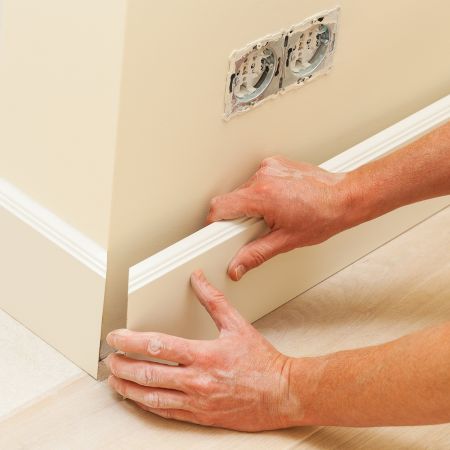
Choosing Skirting Boards and Architraves: A Comprehensive Guide
When it comes to finishing a room, skirting boards and architraves are often overlooked. Yet, these small details play a significant role in defining the overall look and feel of your home. They not only protect walls and door frames from wear and tear but also add a polished, cohesive look to your interiors. Choosing the right skirting boards and architraves can elevate your space from average to outstanding.
Here’s a guide to help you make the best choice for your home.
1. Understand the Purpose of Skirting Boards and Architraves
Before diving into styles and materials, it's important to understand the primary functions of skirting boards and architraves:
· Skirting Boards are installed at the base of walls, providing a neat transition between the wall and the floor. They protect walls from scuffs, knocks, and cleaning equipment while concealing uneven floor edges and cables.
· Architraves are fitted around door frames and windows to cover the gap between the wall and the frame, creating a visually pleasing border that enhances the architectural detail of a room.
Understanding their purpose helps you prioritize both functionality and aesthetics when making your choice.
2. Consider the Style of Your Home
The style of your home is a critical factor when selecting skirting boards and architraves. They should complement your existing interior design and architectural style.
Tips:
· Traditional Homes: For period properties or homes with classic design elements, opt for more ornate skirting boards and architraves, such as Ogee, Torus, or Victorian profiles. These styles have more detail and curvature, matching the elegance of traditional interiors.
· Modern Homes: For contemporary spaces, choose simple and sleek designs like Bullnose or Square Edge. These profiles provide a clean, minimalistic look that aligns with modern interiors.
· Transitional Homes: If your home combines elements of both classic and modern design, opt for styles like the Chamfered profile, which balances subtle detailing with a more streamlined appearance.
3. Select the Right Material
The material you choose for your skirting boards and architraves will impact durability, appearance, and maintenance. Here are the most common options:
· MDF (Medium-Density Fibreboard): A popular and cost-effective choice, MDF is easy to work with, resistant to warping and cracking, and can be primed and painted in any colour. However, it may not be suitable for high-moisture areas like bathrooms.
· Wood (Solid or Engineered): Natural wood offers a premium, authentic appearance and is available in various finishes like oak, pine, or walnut. While more expensive, wood is durable and can be stained or painted. However, it is prone to warping in damp conditions.
· PVC (Polyvinyl Chloride): PVC skirting boards are waterproof, lightweight, and perfect for high-moisture environments. They are low maintenance but may lack the premium feel of wood or MDF.
· Softwood and Hardwood: Softwood (like pine) is less expensive and suitable for painting, while hardwood (like oak or walnut) offers a rich, natural look. Hardwood is more expensive but incredibly durable and long-lasting.
4. Decide on the Profile and Height
The profile (shape) and height of skirting boards and architraves significantly impact the overall look of your room.
Tips:
· Profile: Profiles range from simple, straight lines to more detailed, decorative shapes. Choose a profile that complements your home’s style. A more intricate profile might suit a period property, while a sleek, minimalistic profile works well in modern spaces.
· Height: The height of your skirting board should be proportional to your ceiling height and room size. Taller skirting boards (150mm and above) create a more grand, traditional look and are suitable for rooms with high ceilings. Shorter skirting boards (less than 120mm) are ideal for modern homes with standard ceiling heights.
· Architrave Width: Similar to skirting boards, architraves come in various widths. Wider architraves (70-100mm) are perfect for creating a bold statement, while narrower architraves (50-60mm) offer a subtle and sleek appearance.
5. Think About Colour and Finish
The colour and finish of your skirting boards and architraves can subtly or boldly affect the room’s overall design.
Tips:
· Matching Colours: Paint skirting boards and architraves the same colour as your walls for a seamless look that makes the room feel larger.
· Contrasting Colours: Opt for contrasting colours to create a striking visual effect. For example, white skirting boards and architraves against a darker wall colour can highlight architectural details and add a crisp, clean finish.
· Natural Finishes: If using wood, you can stain or varnish it to enhance its natural grain and beauty. This is ideal for rustic, country, or traditional settings.
6. Consider Durability and Maintenance
Durability is key, especially in high-traffic areas or homes with children and pets.
Tips:
· Choose materials that are easy to clean and maintain, such as MDF or PVC, for practicality.
· For areas prone to moisture, like bathrooms or kitchens, opt for materials that resist water damage, such as PVC or moisture-resistant MDF.
· Wood requires regular maintenance, such as repainting or re-staining, to keep it looking its best.
7. Installation and Cost Considerations
The cost of skirting boards and architraves can vary significantly depending on the material, style, and finish. MDF is generally the most affordable, while hardwood options can be more costly.
Tips:
· Factor in the cost of installation. Professional installation ensures a high-quality finish, particularly for complex profiles or hardwood materials.
· If you’re handy with DIY, simple MDF or PVC skirting boards can be relatively easy to install yourself, saving on labour costs.
8. Think About Continuity Throughout the Home
To create a cohesive look, consider using the same skirting board and architrave style throughout your home. This creates visual flow and makes the design feel intentional and harmonious.
Tips:
· If using different styles in different rooms, ensure there is a natural transition between spaces to avoid a disjointed appearance.
· Consistency in colour and material will help maintain a unified look, even if the profiles vary slightly.
Choosing the right skirting boards and architraves may seem like a small detail, but they can have a significant impact on the overall look and feel of your home. By considering the style, material, profile, height, colour, and durability, you can select options that enhance your interior design while providing practicality and protection. Take your time, explore your options, and consult with professionals if needed to achieve the perfect finishing touch for your home.
Our team of friendly experts can help guide you through choosing the right skirting board and architrave for you, so get in touch now and see how they can help with your next project.
